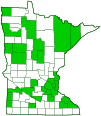golden-eyed lacewing
(Chrysopa oculata)
Conservation • Description • Habitat • Ecology • Distribution • Taxonomy
Conservation Status |
|
|||||||
| IUCN Red List | not listed |
|||||||
| NatureServe | NNR - Unranked |
|||||||
| Minnesota | not listed |
|||||||
Description |
||
Golden-eyed lacewing is a small, very common, typical green lacewing. It occurs in Mexico, in Central America, and throughout North America. It is the most common lacewing in eastern North America. It is common in Minnesota. They are found from May through October on grass, weeds, and shrubs, in fields, meadows, and other relatively open areas. Adults are soft-bodied and small, ½″ to 9⁄16″ (12 to 14 mm) in length. The body is long and slender, and has a delicate appearance. The thorax and abdomen are pale green. There are small dark spots on the exoskeletal plate (pronotum) on the upper side of the thorax. The upper side of the head (vertex) has two pairs of black spots. The lateral groove on the vertex near the margin of the compound eye is completely pale. The upper part of the face (frons) has a black mark. This mark appears as two bold crescents, one below each antennal socket, that meet between the sockets; and a thin line that runs around the outer and upper sides of each socket. There is a red Y-shaped mark between the antennal sockets with arms that stretch well above the sockets. The compound eyes are hemispherical and golden or copper colored. The antennae are hair-like and two-thirds as long as the body. On the base of each antenna on the lower half of upper side there is a reddish band. The band is not separated by a black X-shaped mark. The second antennal segment has a black ring. The wings are pale green and clear with many green veins and many black cross veins. They are at least 25% longer than the body. They appear to be hairless, but there are short hairs along the margins and on the veins that are visible only under magnification. The forewing appears to have just one radial sector. The subcosta vein (Sc) and the anterior branch of the redius (R1) are not fused at the wing tip. The cross veins at the leading (costal) margin are not forked. Third stage (instar) larva is alligator-like in appearance and ¼″ to 5 ⁄16″ long. It has long, sickle-shaped mandibles and well-developed legs which allow it to move quickly. |
||
Size |
||
Total length: ½″ to 9⁄16″ (12 to 14 mm) |
||
Similar Species |
||
Habitat |
||
|
||
Ecology |
||
Season |
||
Three generations per year: May through October |
||
Behavior |
||
Adults are nocturnal, active from sunset to sunrise. They are attracted to lights. They may emit an unpleasant odor when handled. |
||
Life Cycle |
||
The female lays eggs singly on foliage. She can lay two to five eggs per day and several hundred over her lifetime. The eggs are oval and held at the end of long, slender stalks. They hatch in three to six days and the larvae pass through three instars in two to three weeks. They pupate in a silk, pea-shaped cocoon. Pupa overwinter in the soil and adults emerge in the spring. |
||
Larva Food |
||
Mostly aphids |
||
Adult Food |
||
Mostly aphids |
||
Distribution |
||||
|
Sources |
|||
| 9/30/2022 | ||||
Occurrence |
||||
Common in Minnesota |
||||
Taxonomy |
|||
Order |
Neuroptera (antlions, lacewings, and allies) | ||
Suborder |
Hemerobiiformia (lacewings and allies) | ||
Family |
Chrysopidae (green lacewings) | ||
Subfamily |
Chrysopinae (typical green lacewings) | ||
Tribe |
Chrysopini | ||
Genus |
Chrysopa (stink lacewings) | ||
Eight previously recognized subspecies have been raised to genus level, transferred out of this genus, or reduced to synonyms. |
|||
Synonyms |
|||
Chrysopa albicornis Chrysopa conspersa Chrysopa mexicana |
|||
Common Names |
|||
golden-eyed green lacewing golden-eyed lacewing goldeneye lacewing |
|||
Glossary
Costal margin
The leading edge of the forewing of insects.
Frons
The upper front part of an insect’s face, roughly corresponding to the forehead.
Instar
The developmental stage of arthropods between each molt; in insects, the developmental stage of the larvae or nymph.
Pronotum
The exoskeletal plate on the upper side of the first segment of the thorax of an insect.
Vertex
The upper surface of an insect’s head.
Visitor Photos |
|||||
Share your photo of this insect. |
|||||
| This button not working for you? Simply email us at info@MinnesotaSeasons.com. Attach one or more photos and, if you like, a caption. |
|||||
Alfredo Colon |
|||||
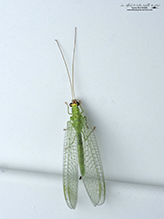 |
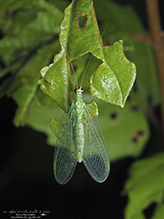 |
||||
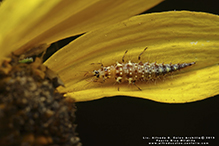 |
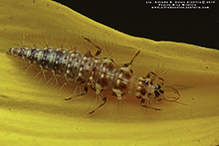 |
||||
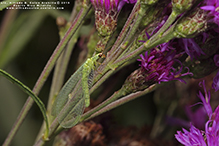 |
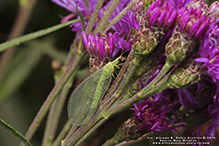 |
||||
Babette Kis |
|||||
Chrysopa oculata golden-eyed lacewing Chrysopa oculata, golden-eyed lacewing, on Sweet black-eyed Susan. Photo taken on Barnes Prairie Remnant, Racine Co., Wisconsin on Sept. 11, 2021. |
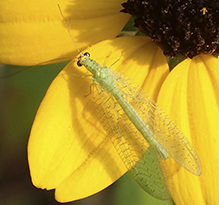 |
||||
MinnesotaSeasons.com Photos |
|||||
|
|||||

Slideshows |
||

Visitor Videos |
|||
Share your video of this insect. |
|||
| This button not working for you? Simply email us at info@MinnesotaSeasons.com. Attach a video, a YouTube link, or a cloud storage link. |
|||
Other Videos |
|||
| Golden-eyed Lacewing (Chrysopidae: Chrysopa oculata) Close-up Carl Barrentine |
|||
About
Jul 29, 2011 Photographed at Fisher, Minnesota (29 July 2011). Thank you to 'v belov' (@Bugguide.net) for confirming the identity of this specimen! |
|||
| Green Lacewing (Chrysopidae: Chrysopa oculata) on Wall Carl Barrentine |
|||
About
Aug 15, 2010 Photographed near Fisher, Minnesota (14 August 2010). |
|||


Created: 10/14/2020
Last Updated:
